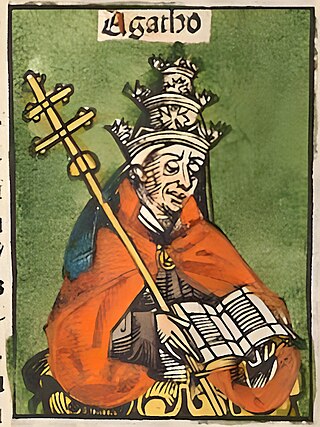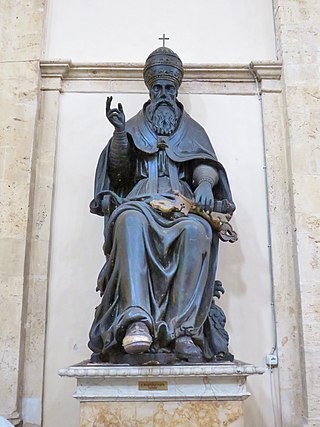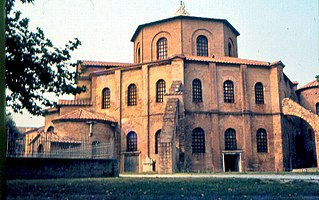Eugene I | |
|---|---|
| Bishop of Rome | |
| Church | Catholic Church |
| Papacy began | 10 August 654 |
| Papacy ended | 2 June 657 |
| Predecessor | Martin I |
| Successor | Vitalian |
| Personal details | |
| Born | |
| Died | 2 June 657 (aged 42) Rome, Byzantine Empire |
| Sainthood | |
| Feast day | 2 June |
| Other popes named Eugene | |
Pope Eugene I (Latin : Eugenius I; died 2 June 657) was the bishop of Rome from 10 August 654 to his death. He was chosen to become Pope after the deposition and banishment of Martin I by Emperor Constans II over the dispute about Monothelitism.
Eugene was a Roman from the Aventine, son of Rufinianus. He was brought up in the Church's ministry, and was already an elderly priest when a dispute flared up between the papacy in Rome, which opposed the monothelite teachings, and the imperial government in Constantinople, which supported it. As a result, Pope Martin I was deposed by Emperor Constans II and carried off from Rome on 18 June 653, eventually ending up banished to Cherson. [1] Little is known about what happened in Rome after Martin's departure, but it was typical in those days for the Holy See to be governed by the archpriest and archdeacon. [2] Martin hoped that a successor would not be elected while he lived, but the imperial court exerted pressure on Rome through the exarch of Ravenna. On 10 August 654, Eugene was appointed the new pope. Martin, though disappointed, seems to have acceded.[ citation needed ] The imperial government believed that Eugene would be cooperative and ratified his election. [1]
As pope, Eugene consecrated twenty-one bishops for different parts of the world and received the youthful Wilfrid on the occasion of his first visit to Rome (c. 654). [2]
Eugene I showed greater deference than his predecessor to the emperor's wishes and made no public stand against the Monothelitism of the patriarchs of Constantinople. [3] One of the first acts of the new pope was to send legates to Constantinople with letters to Emperor Constans II informing him of his election and professing his faith. The legates were deceived, or bribed, and brought back a synodical letter from Patriarch Peter of Constantinople (656–666), while the emperor's envoy, who accompanied them, brought offerings for Saint Peter and a request from the emperor that the pope would enter into communion with the patriarch of Constantinople. Peter's letter proved to be written in a difficult and obscure style and avoided making any specific declaration as to the number of "wills or operations" in Christ. When its contents were read to the clergy and people in the church of St. Mary Major in 656, they not only rejected the letter with indignation, but would not allow the pope to leave the basilica until he had promised that he would not on any account accept it. [2]
The imperial officials were furious at this harsh rejection of the wishes of the emperor and patriarch. [2] Constans threatened to dispose of Eugene just as he had disposed of Martin, [1] but was preoccupied by defending the empire from the Muslim conquests. [2]
Eugene I died on 2 June 657, [4] before Constans II could act against him. He was buried in Old St. Peter's Basilica. [2] He was acclaimed a saint, his day being 2 June. [1] He is commemorated as the patron and namesake of the Cathedral of Saint Eugene in the Diocese of Santa Rosa in California.

Pope Agatho served as the bishop of Rome from 27 June 678 until his death. He heard the appeal of Wilfrid of York, who had been displaced from his see by the division of the archdiocese ordered by Theodore of Canterbury. During Agatho's tenure, the Sixth Ecumenical Council was convened to deal with monothelitism. He is venerated as a saint by both the Catholic and Eastern Orthodox churches.

Pope Honorius I was the bishop of Rome from 27 October 625 to his death. He was active in spreading Christianity among Anglo-Saxons and attempted to convince the Celts to calculate Easter in the Roman fashion. He is chiefly remembered for his correspondence with Patriarch Sergius I of Constantinople over the latter's monothelite teachings. Honorius was posthumously anathematized, initially for subscribing to monothelitism, and later only for failing to end it. The anathema against Honorius I became one of the central arguments against the doctrine of papal infallibility.

Pope Martin I, also known as Martin the Confessor, was the bishop of Rome from 21 July 649 to his death 16 September 655. He served as Pope Theodore I's ambassador to Constantinople and was elected to succeed him as Pope. He was the only pope during the Eastern Roman domination of the papacy whose election was not approved by an imperial mandate from Constantinople. For his strong opposition to Monothelitism, Pope Martin I was arrested by Emperor Constans II, carried off to Constantinople, and ultimately banished to Cherson. He is considered a saint by both the Catholic Church and the Eastern Orthodox Church and he is the last pope recognized as a martyr.

The Third Council of Constantinople, counted as the Sixth Ecumenical Council by the Eastern Orthodox and Catholic Churches, as well as by certain other Western Churches, met in 680–681 and condemned monoenergism and monothelitism as heretical and defined Jesus Christ as having two energies and two wills.
Monothelitism, or monotheletism, is a theological doctrine in Christianity, that holds Christ as having only one will. The doctrine is thus contrary to dyothelitism, a Christological doctrine that holds Christ as having two wills. Historically, monothelitism was closely related to monoenergism, a theological doctrine that holds Jesus Christ as having only one Energeia/Nature. Both doctrines were at the center of Christological disputes during the 7th century.
Pope Theodore I was the bishop of Rome from 24 November 642 to his death. His pontificate was dominated by the struggle with Monothelitism.
Pope Severinus was the bishop of Rome elected in October 638. He was caught up in a power struggle with Emperor Heraclius, who pressured him to accept Monothelitism. Severinus refused, which for over eighteen months hindered his efforts to obtain imperial recognition of his election. His pontificate was finally sanctioned on 28 May 640, but he died two months later.
Pope Constantine was the bishop of Rome from 25 March 708 to his death. One of the last popes of the Byzantine Papacy, the defining moment of his pontificate was his 710/711 visit to Constantinople, where he compromised with Justinian II on the Trullan canons of the Quinisext Council. The city's next papal visit occurred in 1967.
Pope Vitalian was the bishop of Rome from 30 July 657 to his death. His pontificate was marked by the dispute between the papacy and the imperial government in Constantinople over Monothelitism, which Rome condemned. Vitalian tried to resolve the dispute and had a conciliatory relationship with Emperor Constans II, who visited him in Rome and gave him gifts. Vitalian's pontificate also saw the secession of the Archbishopric of Ravenna from the papal authority.

Constans II, nicknamed "the Bearded", was the Byzantine emperor from 641 to 668. Constans was the last attested emperor to serve as consul, in 642, although the office continued to exist until the reign of Leo VI the Wise. His religious policy saw him steering a middle line in disputes between the Orthodoxy and Monothelitism by refusing to persecute either and prohibited discussion of the natures of Jesus Christ under the Type of Constans in 648. His reign coincided with Muslim invasions under Mu'awiya I in the late 640s to 650s. Constans was the first emperor to visit Rome since the fall of the Western Roman Empire in 476, and the last one to visit Rome while it was still held by the Empire.
Pope Adeodatus II, sometimes called Deodatus, was the bishop of Rome from 672 to his death. He devoted much of his papacy to improving churches and fighting monothelitism.
Sergius I was the Ecumenical Patriarch of Constantinople from 610 to 638. He is most famous for promoting Monothelite Christianity, especially through the Ecthesis.
Pyrrhus was the ecumenical patriarch of Constantinople from 20 December 638 to 29 September 641, and again from 9 January to 1 June 654.
Macarius I of Antioch was Patriarch of Antioch in the 7th century, deposed in 681 for professing monothelitism.
Paul II was the Ecumenical Patriarch of Constantinople from 1 October 641 to his death. He assumed regency for Byzantine emperor Constans II after a succession crisis in 641. Stephanos of Clypea appears to have served as secretary/scribe of Patriarch Paulus II of Constantinople against the Monothelites, in 646 AD. He was succeeded by Peter of Constantinople.
The Ecthesis is a letter published in 638 CE by the Byzantine emperor Heraclius which defined monotheletism as the official imperial form of Christianity.
Eugenius was a 4th-century Roman emperor.

The Byzantine Papacy was a period of Byzantine domination of the Roman papacy from 537 to 752, when popes required the approval of the Byzantine Emperor for episcopal consecration, and many popes were chosen from the apocrisiarii or the inhabitants of Byzantine-ruled Greece, Syria, or Sicily. Justinian I reconquered the Italian peninsula in the Gothic War (535–554) and appointed the next three popes, a practice that would be continued by his successors and later be delegated to the Exarchate of Ravenna.

The Lateran Council of 649 was a synod held in the Basilica of St. John Lateran to condemn Monothelitism, a Christology espoused by many Eastern Christians. The Council did not achieve ecumenical status in either East or West, but represented the first attempt of a pope to convene an ecumenical council independent of the Roman emperor.
The Typos of Constans was an edict issued by eastern Roman emperor Constans II in 648 in an attempt to defuse the confusion and arguments over the Christological doctrine of Monotheletism. For over two centuries, there had been a bitter debate regarding the nature of Christ: the orthodox Chalcedonian position defined Christ as having two natures in one person, whereas Miaphysite opponents contended that Jesus Christ possessed but a single nature. At the time, the Byzantine Empire had been at near constant war for fifty years and had lost large territories. It was under great pressure to establish domestic unity. This was hampered by the large number of Byzantines who rejected the Council of Chalcedon in favour of Monophysitism.
{{cite web}}: Missing or empty |url= (help)</ref>